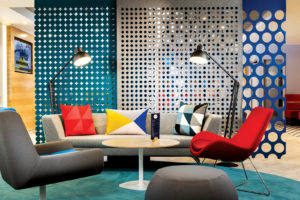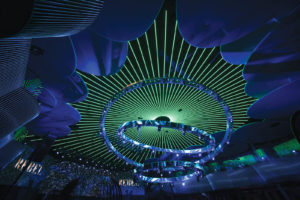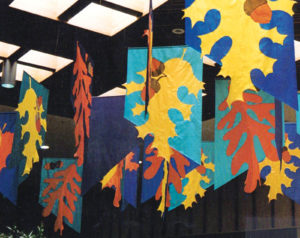
Fabric and lighting have an ages-old relationship that elicits something visceral, and when done skillfully there’s a quality to backlit fabric that nothing else can provide,” says Eric Bury, director of project development for the Toronto, Canada-based custom architectural fabrication company Eventscape. Bury acknowledges that of all the construction materials his company uses to create unique, one-of-a-kind physical environments—many made for entertainment venues, both temporary and permanent—fabric carries a special quality that is hard to duplicate in any other material.
As with most entertainment events, finding and presenting what’s new drives all other factors in their success, including cost. Given that fabric is almost always the lowest cost option in comparison to other materials, its use seems guaranteed in some manner for this market sector going forward.
Entertainment banks its value on offering audiences authentic experiences, a fact that is not lost on analysts or producers seeking new experiences. This truth, in part, is echoed in many other sectors of society today, especially with the “millennial” generation members who reportedly favor the real over the fake, experiences over possessions and rewarding work over utilitarian jobs. Millennials, we’re advised, are increasingly forgoing marriage and home buying in favor of stimulating experiences in all aspects of their lives.
Shaping real spaces

A recent phenomenon that parallels this search for genuine experiences is the “maker” movement. Michael Bierut, a founding partner in the international design consultancy Pentagram, commented in a New York Times column on the recent trend of people craving the handmade object as well as seeking the tactile over the “smooth sheen of the smartphone”: “As daily life becomes increasingly virtual, it might seem like a paradox that making things by hand is suddenly big business. Stores like Michaels and Hobby Lobby feature aisle after crowded aisle with sequins, tassels, imported papers, chenille stems and pompoms.” This is where fabric becomes a strategic player, well-placed to provide fabricators a market advantage.
“Think of the warm glow of a living room shining out to the nighttime through drawn curtains, the light of a dim bulb through a worn lampshade in an otherwise darkened room,” says Bury, continuing his case for the use of fabric in entertainment venues. “Or waking up to the full blaze of the sun as it flares through the canvas of your tent. We can all picture those moments vividly because we’ve all been moved by them, and it still catches my breath when the play of light through fabric evokes similar feelings by masterful design or innovative application.”
“Textiles are often the A surface in a space, the surface that most closely interacts with the user,” says Catherine Stowell, director of design for Designtex. “This means they are a valuable opportunity to make a direct impression, especially in entertainment environments. Textiles can add materiality and texture. In seating, the contrast between a cool hard surface like wood or laminate and a soft surface like felted wool or woven cotton can directly affect the user experience by imbuing a sense of warmth, familiarity or luxury and expense. Textiles can be a vehicle for pattern and color. In vertical applications, walls can become canvases for artistic interventions, hanging panels can be thoughtful fields of color.” Designtex, a Steelcase company, is a leading manufacturer of contract interior textiles and applied materials for the built environment.

“Fabric brings texture and the soft elements to decor,” says Wade Wesson, director of design for Dazian, a longtime major supplier to theater, cinema, retail, exhibit, hospitality and entertainment industries. “In modern architecture environments, where clean lines and open space are the trend, fabrics bring a softer side of elegance as well as much-needed acoustic properties.”
These themes are echoed by Judy Dioszegi, principal of her eponymous design firm: “The ‘atmosphere’ or ‘environment’ of the space sets the story of how one feels upon entering a location,” says Dioszegi. “Sometimes it’s happy and playful and other times more restrained and elegant. Upholstery fabric, wall coverings and art on the walls all have to coordinate and together play an important part in how the client reacts to the space. Many times, I believe, theirs is a subconscious reaction that they might not even be aware of.”
“The use of fabric to create an atmosphere in a space is a wise choice,” says Dioszegi. “It can be changed without much fuss and without moving [existing] structures. Often the initial cost of a fabric installation is the most effective method of creating an atmosphere. Personally, I see one of the greatest benefits as being able to change the whole environment with a fabric change!”
Space, sound and mood
Bury feels that there are almost limitless opportunities for using fabric in architectural form, whether furnishing an interior space or literally creating the walls, roof and windows of a building. “I think what fabric offers most is its versatility,” says Bury. “It can be tight and hard-edged, or loose and soft. It can span large areas seamlessly, or be used as small accent elements. It can be static and permanent, or billowy and ephemeral. It can have texture and depth, or be smooth and monolithic. It can carry inks and dyes, or be used as a reflective or projection surface.”
Not all entertainment spaces need to be loud and flamboyant. Designtex’s Stowell firmly believes textiles can create a sense of privacy and intimacy. “New technological developments have enabled the design of fine sheer materials that allow light and visual transparency while boasting serious acoustical properties, inviting interior designers to rethink the concept of a private space.”

“Yes, fabric is the perfect vehicle for surface texture for LED lighting, and the acoustic values that fabrics add to hard surfaces is still the best option to reducing the noise reduction coefficient (NRC) values when hardscape prefabricated panels are not an option,” says Wesson. In addition, Wesson advocates for fabric as the most affordable option for post-construction acoustical issues. “Without question, the warmth of the soft surface and light feel of fabric add ambiance to any sterile environment.”
Dioszegi comments on the many ways that fabric can fine-tune a space: “Baffle-type banners can also help control the sound; softer gathered fabrics surrounding banquettes can create more intimate settings. Lighting also plays an important role: If it’s too bright or harsh often the client/customer feels uncomfortable; if it’s too dim people can feel uncomfortable as well.”
Designtex has developed a line of fabrics specifically to address acoustical issues while simultaneously hewing to the aesthetical needs of interior designers. Although the data sheet for this line of Acoustic Sheers discusses their application for office and commercial usage, the technical aspects of what it describes could as easily apply to entertainment venues, especially in terms of noise levels: “Many surveys indicate that noise receives the most complaints of any workspace issue. Voices that carry in open office environments have been chief among the complaints, and the market has answered with many products that absorb sound using opaque nonwoven and felt materials. But how do we mitigate noise and reverberation in spaces that have been carefully designed to be pervaded by light?”
The answer, according to Designtex, is to carefully calibrate the sound-dampening qualities of the yarn while pairing it with light transmission levels in a unique approach developed in collaboration with research conducted by Empa, the Swiss Federal Laboratories for Materials Science and Technology. Polyester yarns were engineered to improve acoustical performance by increasing the surface area of the yarn, even while they remained very fine. Also factoring into the product line were weave constructions that break up sound waves, partly absorbing and partly reflecting them.
Constructed and deconstructed
Predicting the future is a precarious sport, yet every business must make plans for future development based mostly on past performance and experience. The group of experts consulted for this article willingly expressed their thoughts on what the entertainment market can expect or hope to expect in the near future using fabric
as a key element:
“There is a growing trend toward industrial atmospheres,” says Dioszegi. “Not only in homes and offices, but also in restaurants. One of our nearby popular restaurants has saw blades and machinery pieces mounted on the walls. Among recent art fairs I’ve attended, I’ve seen wrenches and hammers painted in brilliant colors and ready to install in the home or office. Likewise, different kinds of signage, industrial and otherwise, are ready to be incorporated into an establishment, and these can be printed or appliquéd on fabric to help with atmosphere and acoustics. Clients are often coming up with new requests and there is always someone out there who’s willing to give it a try!”
Dazian’s director of design, Wesson, thinks the current trend of fabric transformed into more architectural type structures has great possibilities: “With the evolution of CAD-based and Google computer software for the structure and modeling of fabric elements, the design and construction of fabric elements [for entertainment] will continue to spur designers,” says Wesson. “More complex structures that can be constructed and then deconstructed are the latest wave of design challenges.”
Designtex sees an increasing market for custom textiles: “Right now we are really excited about the opportunities that come from working closely with designers on projects. While totally custom materials have always been an option (though costly), we are increasingly maximizing the ways we can more effortlessly tweak and tune materials to meet our clients’ distinct concepts,” says Stowell.
What’s next for the entertainment industries? According to Bury: “It’s an exciting time for the use of fabric as a sculptural medium. There’s a lot of innovative research and experimentation happening now that is going to lead to fabric being used in architectural environments in ways that we haven’t seen before. What artist Anish Kapoor did at the Tate Museum is still a high-water mark for textile architecture, the influence of which can be seen very clearly in Zaha Hadid Architects’ stunning work at the Winton Gallery [mathematics exhibition at the London Science Museum] last year. How ETFE [ethylene tetrafluoroethylene] was used on the Water Cube at the Beijing Olympics was groundbreaking, and Diller Scofidio + Renfro’s The Shed at Hudson Yards is about to take it even further. [The Shed is scheduled to open in 2019.] Not to mention what’s happening currently with fabric formwork for cast concrete, the integration of electronics and textiles, reactive and kinetic surfaces, ‘smart’ materials—the list goes on!”
Bruce N. Wright, AIA, consultant to architects and designers, writes frequently about architecture,
design and textiles for Specialty Fabrics Review, Fabric Architecture, Advanced Textiles Source and
other international journals.
Retrofitted acoustical fabric panels in a Canadian art center improve performance and add functionality
Built over 20 years ago, the Toronto Centre for the Arts’ underused main theater needed updating. The solution involved reducing the overall size and upgrading the systems to create a more efficient facility.
Designers of the retrofit, Diamond Schmitt Architects, brought Eventscape into the project to engineer, fabricate and install more than 3,000 sq. ft. of an acoustical backlit panel solution that wrapped the theater walls and proscenium. An unusual chevron design of alternating diffusing and reflecting backers with integrated lighting provides a system that solves both acoustic requirements and allows nearly unlimited options to create programmable light shows.
After a digitized site survey (to detail all the support structure in the original theater house from floor to the 55-ft. ceiling height) Eventscape designed and engineered a coordinated zigzag hanging “rail” system of fabric clad panels.
Enclosed assemblies were built of square aluminum tubing, making for rigid box frames. These were made with laser-cut and brake-formed aluminum sides and fitted with a textile skin front and back that was either acoustically transparent or acoustically reflective, depending on the exact acoustic requirements of the space. The architect chose a custom neutral print color for the textile finish.
With the many different site conditions on the stage, balcony and proscenium, each box frame had a unique acoustic requirement, resulting in 40 different types of enclosure assemblies.
Adding to the challenges, the existing condition of the stairs and ramps in the theater house made installation using a boom or lift equipment impossible. Eventscape used standard scaffolding to hand carry each enclosure assembly to its assigned position. Lights that were incorporated into each enclosure are programmable every 12 inches so that up to four different colors in each enclosure can be permitted at a time.
The completed remodeling surrounds the audience, giving attendees a unique immersive experience.
Fabric environment designer Judy Dioszegi relies on a number of techniques and considerations for improving an interior environment.
A few of her recommendations:
• The ways in which fabrics are suspended,
gathered or pleated can greatly accentuate
the lighting set below or behind the fabric.
• Take time to experiment with different fabrics and different positioning.
• Flatter, shinier surfaces can deflect the sound, but may not really help deaden it.
• A heavier porous fabric absorbs more sound; experimenting
with placement will yield the best results.
There are many creative methods of installation:
• A pulley system gives great flexibility.
• Layering fabrics vertically provides dimension and color changes.
• Cool color fluorescent lights can subconsciously stifle conversations,
while warm lighting can make people feel more relaxed.
Dazian director of design Wade Wesson suggests the following:
• Digital printing on fabric brings pattern, color and messaging. The digital
printing era also offers the ability to introduce custom signature prints
and textures at a much more economical cost.
• The evolution of LED lighting has brought fabric back to the forefront
for surface texture.
• The ability to transport fabric in relatively small compact packages
makes it easily available nationwide.
 TEXTILES.ORG
TEXTILES.ORG


